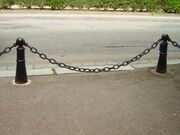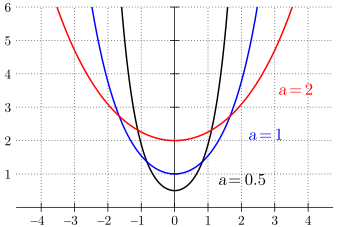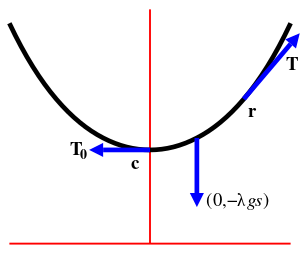سلسلي


منحني سلسلي إنگليزية: catenary أو كاتينا في الفيزياء والهندسة الرياضية هو شكل هندسي نظري يتشكل عند تدلي سلسلة أو سلك عندما تكون طرفيها مثبتين في الأعلى وذلك تحت تأثير قوة الثقالة الأرضية (وزن الجسم المعلق).
الوصف الرياضي
المعادلة العامة
تعطى معادلة شكل المنحني الكاتينري بتابع جيب التمام للقطع الزائد بالشكل:
حيث cosh is the hyperbolic cosine function, and where x is measured from the lowest point.[1] All catenary curves are similar to each other, since changing the parameter a is equivalent to a uniform scaling of the curve.
The Whewell equation for the catenary is[2]
Differentiating gives
and eliminating φ gives the Cesàro equation[3]
The radius of curvature is then
which is the length of the line normal to the curve between it and the x-axis.[4]
العلاقة مع المنحنيات الأخرى
When a parabola is rolled along a straight line, the roulette curve traced by its focus is a catenary.[5] The envelope of the directrix of the parabola is also a catenary.[6] The involute from the vertex, that is the roulette traced by a point starting at the vertex when a line is rolled on a catenary, is the tractrix.[5]
Another roulette, formed by rolling a line on a catenary, is another line. This implies that square wheels can roll perfectly smoothly on a road made of a series of bumps in the shape of an inverted catenary curve. The wheels can be any regular polygon except a triangle, but the catenary must have parameters corresponding to the shape and dimensions of the wheels.[7]
الخصائص الهندسية
Over any horizontal interval, the ratio of the area under the catenary to its length equals a, independent of the interval selected. The catenary is the only plane curve other than a horizontal line with this property. Also, the geometric centroid of the area under a stretch of catenary is the midpoint of the perpendicular segment connecting the centroid of the curve itself and the x-axis.[8]
العلوم
A moving charge in a uniform electric field travels along a catenary (which tends to a parabola if the charge velocity is much less than the speed of light c).[9]
The surface of revolution with fixed radii at either end that has minimum surface area is a catenary revolved about the x-axis.[5]
التحليل
نموذج السلاسل والعقود
In the mathematical model the chain (or cord, cable, rope, string, etc.) is idealized by assuming that it is so thin that it can be regarded as a curve and that it is so flexible any force of tension exerted by the chain is parallel to the chain.[10] The analysis of the curve for an optimal arch is similar except that the forces of tension become forces of compression and everything is inverted.[11] An underlying principle is that the chain may be considered a rigid body once it has attained equilibrium.[12] Equations which define the shape of the curve and the tension of the chain at each point may be derived by a careful inspection of the various forces acting on a segment using the fact that these forces must be in balance if the chain is in static equilibrium.
Let the path followed by the chain be given parametrically by r = (x, y) = (x(s), y(s)) where s represents arc length and r is the position vector. This is the natural parameterization and has the property that
where u is a unit tangent vector.
A differential equation for the curve may be derived as follows.[13] Let c be the lowest point on the chain, called the vertex of the catenary.[14] The slope dy/dx of the curve is zero at c since it is a minimum point. Assume r is to the right of c since the other case is implied by symmetry. The forces acting on the section of the chain from c to r are the tension of the chain at c, the tension of the chain at r, and the weight of the chain. The tension at c is tangent to the curve at c and is therefore horizontal without any vertical component and it pulls the section to the left so it may be written (−T0, 0) where T0 is the magnitude of the force. The tension at r is parallel to the curve at r and pulls the section to the right. The tension at r can be split into two components so it may be written Tu = (T cos φ, T sin φ), where T is the magnitude of the force and φ is the angle between the curve at r and the x-axis (see tangential angle). Finally, the weight of the chain is represented by (0, −λgs) where λ is the mass per unit length, g is the gravitational field strength and s is the length of the segment of chain between c and r.
The chain is in equilibrium so the sum of three forces is 0, therefore
and
and dividing these gives
It is convenient to write
which is the length of chain whose weight is equal in magnitude to the tension at c.[15] Then
is an equation defining the curve.
The horizontal component of the tension, T cos φ = T0 is constant and the vertical component of the tension, T sin φ = λgs is proportional to the length of chain between r and the vertex.[16]
اشتقاق المعادلات للمنحنى
The differential equation given above can be solved to produce equations for the curve.[17]
من
the formula for arc length gives
Then
and
The second of these equations can be integrated to give
and by shifting the position of the x-axis, β can be taken to be 0. Then
The x-axis thus chosen is called the directrix of the catenary.
It follows that the magnitude of the tension at a point (x, y) is T = λgy, which is proportional to the distance between the point and the directrix.[16]
This tension may also be expressed as T = T0 y/a .
The integral of the expression for dx/ds can be found using standard techniques, giving[18]
and, again, by shifting the position of the y-axis, α can be taken to be 0. Then
The y-axis thus chosen passes through the vertex and is called the axis of the catenary.
These results can be used to eliminate s giving
اشتقاق بديل
The differential equation can be solved using a different approach.[19] From
it follows that
and
Integrating gives,
and
As before, the x and y-axes can be shifted so α and β can be taken to be 0. Then
and taking the reciprocal of both sides
Adding and subtracting the last two equations then gives the solution
and
تحديد المتغيرات
In general the parameter a is the position of the axis. The equation can be determined in this case as follows:[20]
Relabel if necessary so that P1 is to the left of P2 and let H be the horizontal and v be the vertical distance from P1 to P2. Translate the axes so that the vertex of the catenary lies on the y-axis and its height a is adjusted so the catenary satisfies the standard equation of the curve
and let the coordinates of P1 and P2 be (x1, y1) and (x2, y2) respectively. The curve passes through these points, so the difference of height is
and the length of the curve from P1 to P2 is
When s2 − v2 is expanded using these expressions the result is
so
This is a transcendental equation in a and must be solved numerically. It can be shown with the methods of calculus[21] that there is at most one solution with a > 0 and so there is at most one position of equilibrium.
However, if both ends of the curve (P1 and P2) are at the same level (y1 = y2), it can be shown that[22]
where L is the total length of the curve between P1 and P2 and h is the sag (vertical distance between P1, P2 and the vertex of the curve).
It can also be shown that
and
where H is the horizontal distance between P1 and P2 which are located at the same level (H = x2 − x1).
The horizontal traction force at P1 and P2 is TH = aw, where w is the mass per unit length of the chain or cable.
Variational formulation
Consider a chain of length suspended from two points of equal height and at distance . The curve has to minimize its potential energy
and is subject to the constraint
The modified Lagrangian is therefore
where
is the Lagrange multiplier to be determined. As the independent variable
does not appear in the Lagrangian, we can use the Beltrami identity
where
is an integration constant, in order to obtain a first integral
This is an ordinary first order differential equation that can be solved by the method of separation of variables. Its solution is the usual hyperbolic cosine where the parameters are obtained from the constraints.
التعميمات مع قوة رأسية
سلاسل غير منتظمة
If the density of the chain is variable then the analysis above can be adapted to produce equations for the curve given the density, or given the curve to find the density.[23]
Let w denote the weight per unit length of the chain, then the weight of the chain has magnitude
where the limits of integration are c and r. Balancing forces as in the uniform chain produces
and
and therefore
Differentiation then gives
In terms of φ and the radius of curvature ρ this becomes
Suspension bridge curve

A similar analysis can be done to find the curve followed by the cable supporting a suspension bridge with a horizontal roadway.[24] If the weight of the roadway per unit length is w and the weight of the cable and the wire supporting the bridge is negligible in comparison, then the weight on the cable (see the figure in Catenary#Model of chains and arches) from c to r is wx where x is the horizontal distance between c and r. Proceeding as before gives the differential equation
This is solved by simple integration to get
and so the cable follows a parabola. If the weight of the cable and supporting wires is not negligible then the analysis is more complex.[25]
سلسلي متساوي القوة
In a catenary of equal strength, the cable is strengthened according to the magnitude of the tension at each point, so its resistance to breaking is constant along its length. Assuming that the strength of the cable is proportional to its density per unit length, the weight, w, per unit length of the chain can be written T/c, where c is constant, and the analysis for nonuniform chains can be applied.[26]
In this case the equations for tension are
Combining gives
and by differentiation
where ρ is the radius of curvature.
The solution to this is
In this case, the curve has vertical asymptotes and this limits the span to πc. Other relations are
The curve was studied 1826 by Davies Gilbert and, apparently independently, by Gaspard-Gustave Coriolis in 1836.
Recently, it was shown that this type of catenary could act as a building block of electromagnetic metasurface and was known as "catenary of equal phase gradient".[27]
سلسلي مرن
In an elastic catenary, the chain is replaced by a spring which can stretch in response to tension. The spring is assumed to stretch in accordance with Hooke's Law. Specifically, if p is the natural length of a section of spring, then the length of the spring with tension T applied has length
where E is a constant equal to kp, where k is the stiffness of the spring.[28] In the catenary the value of T is variable, but ratio remains valid at a local level, so[29]
The curve followed by an elastic spring can now be derived following a similar method as for the inelastic spring.[30]
The equations for tension of the spring are
and
from which
where p is the natural length of the segment from c to r and λ0 is the mass per unit length of the spring with no tension and g is the gravitational field strength. Write
so
Then
from which
Integrating gives the parametric equations
Again, the x and y-axes can be shifted so α and β can be taken to be 0. So
are parametric equations for the curve. At the rigid limit where E is large, the shape of the curve reduces to that of a non-elastic chain.
تعميمات أخرى
Chain under a general force
With no assumptions being made regarding the force G acting on the chain, the following analysis can be made.[31]
First, let T = T(s) be the force of tension as a function of s. The chain is flexible so it can only exert a force parallel to itself. Since tension is defined as the force that the chain exerts on itself, T must be parallel to the chain. In other words,
where T is the magnitude of T and u is the unit tangent vector.
Second, let G = G(s) be the external force per unit length acting on a small segment of a chain as a function of s. The forces acting on the segment of the chain between s and s + Δs are the force of tension T(s + Δs) at one end of the segment, the nearly opposite force −T(s) at the other end, and the external force acting on the segment which is approximately GΔs. These forces must balance so
Divide by Δs and take the limit as Δs → 0 to obtain
These equations can be used as the starting point in the analysis of a flexible chain acting under any external force. In the case of the standard catenary, G = (0, −λg) where the chain has mass λ per unit length and g is the gravitational field strength.
هندسة معمارية

القوس السلسلي هو محل هندسي للنقط التي كل منها تحمل نفس الوزن من مجموع الوزن الكلي للقوس، ولهذا يُستخدم في إنشاء الهياكل المعماريه. الهياكل التي تُصنع بشكل سلسلي تعاني من قوة الشد فقط، كما يحدث في الحبال التي تدعم الجسور معلقه. أو من قوة الضغط عندما الهيكل يبنى على شكل منعكس بالنسبة إلى خط افقي ، كما هو الحال في هياكل القبب (على سبيل المثال قبة في سانت بول في لندن التي صممها روبرت هوك وفي الأقواس التي صممها لاول مرة المهندس الإسباني انطونيو كاودي. بعد ذلك أُستخدم القوس السلسلي في الهندسه المعماريه وفي بناء الجسور (على سبيل المثال في جسور مايلارت وفي السكك الحديديه لكارابيت ).
انظر أيضاً
- Catenary arch
- Chain fountain or self-siphoning beads
- Overhead catenary – power lines suspended over rail or tram vehicles
- Roulette (curve) – an elliptic/hyperbolic catenary
- Troposkein – the shape of a spun rope
- Weighted catenary
- جسر معلق
الهامش
- ^ Weisstein, Eric W. "Catenary". MathWorld--A Wolfram Web Resource. Retrieved 2019-09-21.
The parametric equations for the catenary are given by x(t) = t, y(t) = [...] a cosh(t/a), where t=0 corresponds to the vertex [...]
- ^ خطأ استشهاد: وسم
<ref>غير صحيح؛ لا نص تم توفيره للمراجع المسماةLockwood122 - ^ MathWorld, eq. 7
- ^ Routh Art. 444
- ^ أ ب ت Yates, Robert C. (1952). Curves and their Properties. NCTM. p. 13.
- ^ Yates p. 80
- ^ Hall, Leon; Wagon, Stan (1992). "Roads and Wheels". Mathematics Magazine. 65 (5): 283–301. doi:10.2307/2691240. JSTOR 2691240.
- ^ Parker, Edward (2010). "A Property Characterizing the Catenary". Mathematics Magazine. 83: 63–64. doi:10.4169/002557010X485120. S2CID 122116662.
- ^ Landau, Lev Davidovich (1975). The Classical Theory of Fields. Butterworth-Heinemann. p. 56. ISBN 978-0-7506-2768-9.
- ^ Routh Art. 442, p. 316
- ^ Church, Irving Porter (1890). Mechanics of Engineering. Wiley. p. 387.
- ^ Whewell p. 65
- ^ Following Routh Art. 443 p. 316
- ^ Routh Art. 443 p. 317
- ^ Whewell p. 67
- ^ أ ب Routh Art. 443 p. 318
- ^ Following Routh Art. 443 p/ 317
- ^ Use of hyperbolic functions follows Maurer p. 107
- ^ Following Lamb p. 342
- ^ Following Todhunter Art. 186
- ^ See Routh art. 447
- ^ Archived at Ghostarchive and the Wayback Machine: "Chaînette - partie 3 : longueur". YouTube.
- ^ Following Routh Art. 450
- ^ Following Routh Art. 452
- ^ Ira Freeman investigated the case where only the cable and roadway are significant, see the External links section. Routh gives the case where only the supporting wires have significant weight as an exercise.
- ^ Following Routh Art. 453
- ^ Pu, Mingbo; Li, Xiong; Ma, Xiaoliang; Luo, Xiangang (2015). "Catenary Optics for Achromatic Generation of Perfect Optical Angular Momentum". Science Advances. 1 (9): e1500396. Bibcode:2015SciA....1E0396P. doi:10.1126/sciadv.1500396. PMC 4646797. PMID 26601283.
- ^ Routh Art. 489
- ^ Routh Art. 494
- ^ Following Routh Art. 500
- ^ Follows Routh Art. 455
- ^ Hymers, Paul (2005). Planning and Building a Conservatory. New Holland. p. 36. ISBN 1843309106.
وصلات خارجية
- O'Connor, John J.; Robertson, Edmund F., "Catenary", MacTutor History of Mathematics archive, University of St Andrews.
- قالب:PlanetMath
- Catenary curve calculator
- Catenary at The Geometry Center
- "Catenary" at Visual Dictionary of Special Plane Curves
- The Catenary - Chains, Arches, and Soap Films.
- Cable Sag Error Calculator – Calculates the deviation from a straight line of a catenary curve and provides derivation of the calculator and references.
- Dynamic as well as static cetenary curve equations derived – The equations governing the shape (static case) as well as dynamics (dynamic case) of a centenary is derived. Solution to the equations discussed.
- The straight line, the catenary, the brachistochrone, the circle, and Fermat Unified approach to some geodesics.
- Ira Freeman "A General Form of the Suspension Bridge Catenary" Bulletin of the AMS







